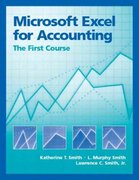Question
1. The design of an accounting system begins with the: A) Previous year's financial statements B) Chart of accounts C) Use of a firewall D)
1. The design of an accounting system begins with the:
A) Previous year's financial statements
B) Chart of accounts
C) Use of a firewall
D) Opening trial balance
2. Every transaction recorded in the cash receipts journal includes a:
A) Debit to Cash
B) Debit to Sales Discounts
C) Credit to Cash
D) Debit to Accounts Receivable
3. Entries in the purchases journal are posted to the:
A) General ledger and the accounts receivable subsidiary ledger
B) General ledger and the accounts payable subsidiary ledger
C) General ledger only
D) Accounts receivable subsidiary ledger and the accounts payable subsidiary ledger
4. Special journals help most by:
A) Limiting the number of transactions that have to be recorded
B) Reducing the cost of operating the accounting system
C) Easing the preparation of the financial statements
D) Improving accuracy in posting to subsidiary ledgers
5. Every transaction recorded in the cash payments journal include:
A) Credit to inventory.
B) Debit to accounts payable.
C) Credit to cash.
D) Debit to another account.
6. Centex Sound Systems purchased inventory costing $8,000 on account. Where should Centrex record this transaction, and what account should be credited:
A) Purchases journal, credit Accounts Payable.
B) General journal, credit Inventory.
C) Cash payments journal, credit Cash.
D) Sales journal, credit Sales Revenue.
7. The individual accounts in accounts receivable subsidiary ledger identify:
A) Amounts to be paid.
B) Suppliers.
C) Payees.
D) Debtors.
8. What control function is performed by auditors?
A) Guarantee that company employees have behaved ethically.
B) Objective opinion on the fair presentation of the financial statements.
C) Assurance that all transactions are accounted for correctly.
D) Communication of the results of the audit to regulatory agencies.
9. The bank account serves as a control device over:
A) Cash receipts.
B) Cash payments.
C) Both of the above.
D) None of the above.
10. Which of the following is an objective of internal control:
A) Safeguarding assets.
B) Maintaining reliable control systems.
C) Preventing and detecting fraud and errors.
D) Optimizing the use of resources.
E) All of the above are objectives of internal control.
11. Which of the following items appear on the Bank side of a bank reconciliation:
A) Outstanding cheque.
B) Interest revenue earned on bank balance.
C) Book error.
D) NSF cheque.
12. The internal control feature that is specific to petty cash is:
A) The imprest system.
B) Assignment of responsibilities.
C) Separation of duties.
D) Proper authorization.
13. The function of the credit department is to:
A) Write off uncollectible accounts receivable.
B) Collect accounts receivable from customers.
C) Report bad credit risks to other companies.
D) Evaluate customers who apply for credit.
14. The credit balance in Allowance for Doubtful Accounts is $12,600 prior to the adjusting entries at the end of the period the accounts indicates that an allowance of $81,200 is needed. The amount of expense to record is:
A) $62,000.
B) $68,200.
C) $68,600.
D) $61,380.
15. The best step to ensure good internal controls in the payroll area is:
A) Separating payroll duties.
B) Using a payroll bank account.
C) Using a payroll register.
D) Using time cards.
16. The main reason for using a separate payroll bank account is to:
A) Safeguard cash by limiting paycheques to amounts based on time cards.
B) Safeguard cash by preventing the writing of payroll cheques to fictitious employees.
C) Increase efficiency by isolating payroll disbursements for analysis and control.
D) All of the above.
17. Which of the following represents a cost to the employer?
A) Withheld income tax.
B) Employment Insurance.
C) Canada Pension Plan.
D) Both B and C.
18. The total payroll expense of the employer is equal:
A) Net pay plus employee withholdings
B) Gross pay plus employees' income tax
C) Net pay plus employer payroll taxes and fringe benefits
D) Gross pay plus employer payroll contributions and fringe benefits
19. Which of the following liabilities creates no expense for the company?
A) Interest
B) Warranty
C) Sales tax
D) Employment Insurance
20. A $11,000, 10 percent, one-year note payable was issued on July 31. The balance sheet at December 31 will report interest payable of: (Use 365 days per year when calculating interest accruals and expense.)
A) $638.90
B) $0, because interest is not due yet
C) $461.10
D) $1,100.00
Step by Step Solution
There are 3 Steps involved in it
Step: 1

Get Instant Access to Expert-Tailored Solutions
See step-by-step solutions with expert insights and AI powered tools for academic success
Step: 2

Step: 3

Ace Your Homework with AI
Get the answers you need in no time with our AI-driven, step-by-step assistance
Get Started


